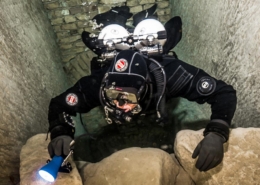By: Pete Nawrocky
The concept of the DEMO day is not a new idea, dive manufacturers have used this concept for years. The advantage is using equipment before purchasing, “try before you buy”. The customer gets the experience of diving a new configuration or technology. Advantages and features not only are explained but the experience is worth the time. This works if you are the manufacturer. Dive educators are not in the primary business of selling gear, the first hurdle is acquiring demo gear. Not every manufacturer has the ability to ship equipment all over the country and it’s impossible to answer every request. The secondary factor is the liability issue; the educator must have a certification to teach the equipment in question. Drysuit diving, sidemount, CCR, and other equipment require this certification to have liability coverage. Demos are about selling gear, a part of the sales process. Personally, I have had the advantage of both sides, working for manufacturers performing demo dives and still an active educator. Over a number of years I’ve noticed more questions on technique coupled with the gear used on the demo. Any instructor skillful in the use of a drysuit actually initiates the sale and can have the student work with them in a drysuit class. Ultimately, the DEMO is about YOU!
DEMO vs. Mentoring
Let’s approach this from another angle, we have established that demos are a sales process. So this begs the question, who wants a commercial? If there is a demo event setup and the plan is to demo Sidemount and Drysuit, a separate liability form is required for each demo. Since both require specialized training, doing both at the same time is ill advised and you may not be covered if there is an incident. So what is the angle?
Instructors are Dive Educators, the object is to have students want to take training with you. Therefore, let’s look at creating a “DEMO” that applies to your forte’. When creating a Mentor day, the concept is to showcase your skills and abilities; students want to “Learn from the Master.” Although students were taught many skills in dive classes an event that reinforces the rudiments will always be welcome. Therefore, the target audience is EVERYBODY.
Proper Trim
Buoyancy control is a skill that needs practice and reinforcement. The educators ability to maintain trim and handle equipment is the first building block in building a level of confidence. Maintain proper trim in a drysuit sells a drysuit class without having to say much of anything. Demonstrating bailout/demo cylinder while remaining neutral is an eye opener for the novice. Fin kicks the students haven’t used and the reason for the use. These may have been introduced in the class but working on the frog kick, helicopter turn, back kick and others are a part of a mentoring program. There are exercises that can be used to build on more skills without even realizing it.
Kick Cycle Drill
One example would be time/kick cycles over distance: the concept is having a 100 foot line placed on the bottom, students are to count the number of kick cycles it takes to cover the distance. It is to be swam 4 times and an average is taken, the drill also includes timed swims. To save time, some instructors like to use a tape measure secured to the bottom. That works but it is possible to add a number of learning experiences to this drill. First use a reel, mark the starting point with three knots or any number of other techniques, colored thread, coloring the line etc… and mark the 50 foot spot and finish with three marks at one hundred feet. Have the class run the line, show them how to hold the reel and then hand it off. At the starting and ending marks install line arrows, the 50 foot mark gets a non-directional marker. Demonstrate installation then hand it off to the students. As simple as this sounds having this done while maintaining neutral buoyancy becomes a learning experience. After performing the swims have the class take up the line. You have just introduced a few basic skills to advanced, intro to tech and wreck/cavern classes.
Lift Bags
This is one of the skills that can be worked as a team project.
You will need the following:
- Lift Bag (50 lb. lift will do)
- 4 uneven pieces of line thick enough to work with dry or heavy gloves
- Milk carton or reasonable facsimile
The first skill is to introduce three knots; here are a couple of suggestions: the bowline, clove hitch and the sheet bend. Explain the function of each knot, practicing on the surface first makes this easy underwater. The bowline and the clove hitch are used to secure the lines to the milk carton. The sheet bend is used to tie one line to another. The drill is to create a 4 point cradle to attach the lift bag.
Each team member is assigned a knot and one member to inflate the lift bag. This entire exercise is performed underwater. Putting rocks or bring weights down to fill the milk carton. Not necessary to overfill, just enough to make the lift bag functional. The entire drill is to be accomplished while neutral. Additional skills include proper storage of the lift bag and other items on the divers kit. A slate helps for any communication issues. This dive builds on search and recovery and Public Safety skills for those on this path.
The Mentoring Day Program can be approved by SDI/TDI headquarters. This will cut down on paperwork as the student folder is used for student registration and liability forms. A certification card will be issued upon successful completion. Students can participate in diving with the kit they currently use. Contact SDI/TDI for registration as an Instructor.









 Natalie L. Gibb
Natalie L. Gibb
Hinterlasse einen Kommentar
An der Diskussion beteiligen?Hinterlasse uns deinen Kommentar!